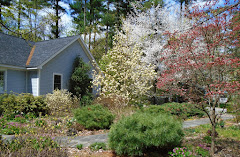The winter of 2023-2024 was fairly well non-existent in eastern Massachusetts. There was rain - lots of rain - but not a single plowable snowfall in Medfield, the town Betty and I have called home for the past quarter century. There were nor'easters that brought near-hurricane-force winds to the region, but the ponds never froze. As a result, we lost no trees or shrubs; the perennials did not get heaved out of the ground. In this, the first full week of May, the garden is a sea of new green with bursts of color from all the usual suspects. Please double-click on any photo to get a full-screen slideshow of the garden.

Sometimes, though, words get in the way of things. Rather than wax poetic, I'd like to let the garden speak for itself. Let me start with the first tree to bloom. This is Amelanchier 'Autumn Brilliance'. It was, if memory serves correctly, the first tree to be planted on the property in June 2015. It wasn't so much an honor bestowed as a practical reality: Betty and I were still driving from nursery to nursery looking for 'the right' specimens. Weston Nurseries had exactly the Amelanchier in stock we wanted and so we brought it home and dug a hole in what we hoped would be the right place.
Our Amelanchier's bloom is brief. This photo shows it at its peak on April 23. Two weeks later, the leaves have eclipsed the blooms.
Magnolia 'Elizabeth' bloomed right behind the Amelanchier. It us a glorious shade of yellow and it fairly glows. This photo is from April 30 and shows the tree at or near its peak. 'Elizabeth' is supposed to get to roughly 25 feet in height and then stop. By my estimate, it has reached its mature status. The tree is still in bloom, but much of its earliest flowers have dropped to the ground. In another week it will be all green - though still a lovely tree.
New England wouldn't be New England without azaleas and rhododendron (the latter is technically a subset of the former). We have multiple specimens, but it is Azalea 'Weston's Aglo' that beats all the others to display the first color. This pair are readily visible from our library. In the photo at left, Magnolia 'Elizabeth' stands at peak glory in the background. There are other azaleas and rhododendron dotted around the property. They'll bloom as late as mid-June.
Fothergilla is largely overlooked in garden design. Part of their lack of broad appeal is that their leaves are a dull green. The exception is 'Blue Shadow', which offers a much more attractive leaf color. But, for a few weeks in May, all Fothergilla have a stunning white brush-like flower. Some are round balls; F Blue Shadow's bloom looks like a bottle brush straight out of a Williams Sonoma catalog. We have three groups of three on the property; one of which is shown in the left third of the adjacent photo.
Which brings us to Cornus florida, the American dogwood. It was only today, May 7, that ours burst out in its full glory. Cornus florida has a bad rap: that it is disease prone, specifically anthracnose which can kill the tree. Cornus kousa, the Korean variant, is considered immune to the disease. The solution, though, isn't to abandon the native version. Rather, it is to give Cornus florida an open space to ensure adequate air flow.
Why does it matter? Because our native birds can eat the small, thin-skilled fruit of the native tree. The large, rubbery-skinned Korean fruit falls to the ground and rots.
There are other, less grand blooms around the property. For example, the Tiarellas are in bloom. Betty acquired 120 Tiarellas and Heucheras in a sharp deal at the 2015 Boston Flower & Garden Show; taking them off the hands of an exhibitor for the price of the plugs - one dollar each. Three months later, having pampered the plants with daily excursions into the sun, we placed them all over the property. What you see at the right, blooming white, are maybe ten of those Tiarella, interspersed with ginger as a foundation planting for our garage.
Finally, we are endeavoring to use as many native groundcovers as possible to eliminate the need for grass. At the front of our property there's a growing expanse of Arctostaphylos uva-ursi, otherwise known as bearberry. It's a terrific groundcover, but its bloom is what is called 'insignificant'... a flower you need a magnifying glass to see. Not so Phlox stolonifera, shown at left. For about three weeks, it puts up a glorious blue flower spike. Then, the flower fades and the spike browns. We're left with a green mat of phlox that takes light foot traffic. What you see here started as three plugs back in 2015. It's now about nine square feet and expanding at a rate of about two square feet a year.
That's how the garden looks this spring. Hope you enjoyed the visit!








No comments:
Post a Comment